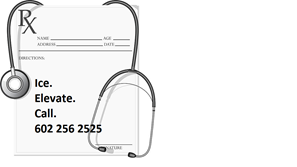Achilles tendon rupture requires surgical repair, and the sooner the better. The Achilles tendon is the largest in our bodies and connects the calf muscles with the heel. Achilles tendon rupture is common during sports; it feels like you were kicked, then you have pain and weakness in the ankle. You can feel the tear, but our surgeons want an MRI and visit with them as soon as possible. If you are medically fit for surgery, you should anticipate MRI and surgeon visit the day after the injury with surgery the day after that.
The Achilles tendon is about the thickness of a piece of celery. When the calf muscles contract the Achilles tendon pulls the heel up, thereby levering the midfoot and toes downward. This motion is important in walking, running, and jumping.
If you think you may have ruptured your Achilles tendon apply ice right away, elevate your foot, and call a podiatrist. They will arrange an urgent magnetic resonance imaging scan or your ankle as well as a clinic visit.

The podiatrist will feel along your injured Achilles tendon for a gap at the site of the tear. Your doctor will also perform the squeeze test. With your ankle bend she will squeeze your calf muscles. If your Achilles tendon is intact, then squeezing the calf should flex your foot.
If your physical examination and magnetic resonance imaging (MRI) confirm tendon rupture, then urgent repair is indicated. Older folks and those with chronic medical conditions (heart disease, COPD, diabetes, kidney failure, etc.) may elect for non-operative treatment. A cast is placed with the foot flexed toward the ground in an attempt to move the ends of the ruptured Achilles tendon closer together for healing for 6-12 weeks.
The type of surgery required depends on how fast you get to us. If you contacted us quickly and stayed off the foot then today, we have minimally invasive options. Your surgeon will discuss your options based on the findings shown on the MRI of your tendon.
Achilles tendon repair surgery is not major surgery, and is done in our ambulatory surgery center, so a hospital stay is not needed. Minimally invasive Achilles tendon repair surgery takes 45 minutes.
Tradition achilles tendon repair requires a longer incision and takes 75-90 min. The ends of the ruptured tendon are freed up then sewn back together.
After surgery your leg is placed in a splint, and the tendon allowed to heal. Rehabilitation afterward typically takes 4-6 months for routine function and ten months for return to competitive sports.
You can still walk after an Achilles tendon rupture, but usually with a limp, and you shouldn’t. Kobe Bryant’s Achilles tendon rupture was captured on live television.
Dr Zachary Flynn DPM answers the question: Can You Walk On An Achilles Rupture
At 1:23 Kobe ruptures his Achilles tendon, then limps down the court with what MRI will show to be a completely torn tendon. He takes a couple of brave free throws after that, as well. Waling causes the torn edges of the tendon to retract. The recommendation today is for people who are healthy enough to undergo surgery to have a repair within days of surgery. The father apart the edges of the ligament are the more complex the repair. Walking and using the ankle after an Achilles rupture therefore makes a bad situation worse.
Dr Zachary Flynn DPM on RECOVERY after Achilles tend rupture surgery Recovery
For most people recovery from Achilles tendon rupture takes four to six months. Young and middle-aged people without chronic medical condition who want to get back to an active lifestyle will need to have surgical repair of their ruptured Achilles tendon. During surgery, the ruptured ends of the tendon are freed up and sewn back together. After the surgery, the leg is placed in a split or boot to hold it still while the ends of the tendon heal together.
Healing takes 4-6 weeks and is followed by rehabilitation. Immediately after surgery the patient is placed in a foot and ankle cast for 2 weeks followed by re-casting. After four week as long as the skin is healing then it’s time for a walking boot and physical therapy. After week eight patients can walk with a scooter and boot. By week 14 you can walk on the boot only and gradually wean off the boot. You should be back in a shoe by then. Physical therapy on a treadmill or aquatic therapy are both good options. Everyone is different, but weekend warriors typically require 4-6 months of rehabilitation, while elite athletes average 10 months to reach maximal improvement and readiness for professional sports.
To a degree. By casting the leg with the foot in the flexed down position the torn edges of the tendon are forced as close together as possible. The body then does what it can to heal. However, the edges of the ruptured tendon recoil after they are cut, and therefore will not heal directly together without surgery.
There are several studies showing similar long-term results between groups who had surgery and those who did not; however, it’s hard to evaluate these results because people who highly motivated to return to as normal as possible all undergo surgery. The advantages of surgery are less down time and lower likelihood of repeat rupture. Without surgical repair the likelihood another rupture is 30 – 40%. The advantages of casting are not having to undergo surgery and lower cost.
The Achilles is the most common tendon rupture in America. There are over 1,000,000 Achilles injuries each year.







